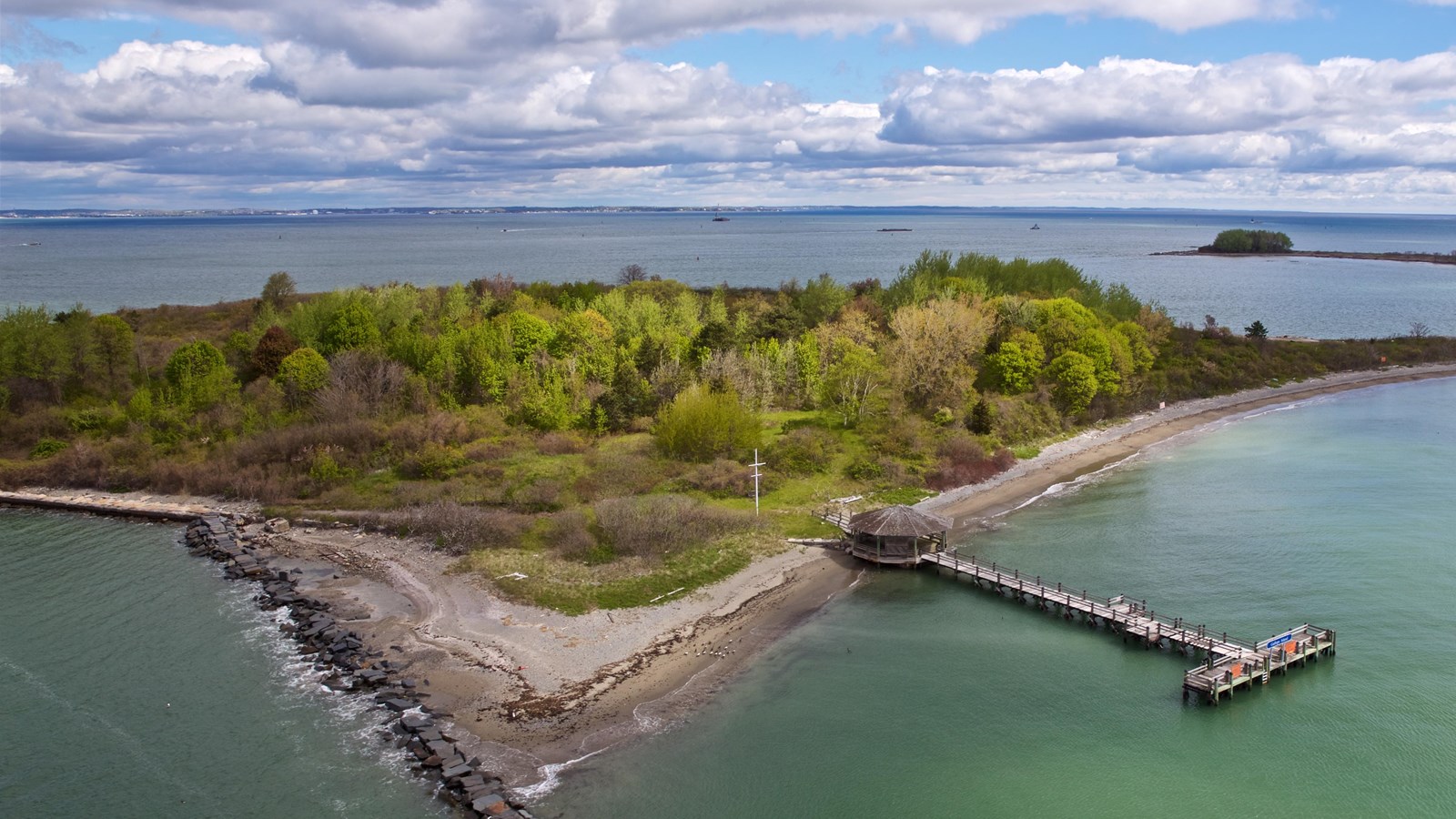Last updated: October 27, 2023
Place
Gallops Island

Boston Harbor Islands/Liz Cook
Six miles from Long Wharf, sits the 50- acre Gallops Island. The island is composed of one drumlin that is 79 feet. The island offers wonderful views of the harbor and surrounding islands.
Like other islands in the harbor, indigenous people accessed the island seasonally for thousands of years before colonization.
In 1635, Captain John Gallops took ownership of the island, becoming the island’s namesake. Captain Gallops served as one of the earliest harbor pilots in the area.i 1800s. During the Revolutionary War, French troops built earthen batteries and even mounted guns on the island.1
In 1819, Peter and Margaret Newcomb purchased the island to use as farmland. Eight years later, the federal government spent over $2,000 dollars to have a gravel cliff cut off the island to improve Fort Warren’s defensive abilities. Peter Newcomb passed away in 1833. Following his death, Margaret Newcomb opened a resort and inn on the island, which became successful. During this time, she referred to the island as "Newcomb’s Island." Newcomb eventually sold the business to Joseph Snow, who continued to operate the inn and restaurant. In 1852, the city of Boston operated a pauper's home on the island. The city purchased the island in 1856 for $6,000 dollars and continued to use the island as a pauper's home.2
In the 1860s, Boston deeded the island to the federal government. During the Civil War, the island served as a facility for both quartering and training. The military built 20 barracks on the island to house 3,000 soldiers. Around this time, the Newcomb Inn also closed, due to lack of visitation.3
Many local regiments also “mustered in” on Gallops Island, before finishing their service. Two of the most notable instances of this are the 54th and 55th Massachusetts regiments, two of the first all-Black regiments in the United States. The 54th Regiment arrived on Gallops Island in late August of 1865, and stayed on the island until September 2 when they returned to Boston. Greeted by an enthusiastic crowd, and served a hearty meal, they disbanded at the end of the festivities. The 55th Regiment arrived on Gallops Island shortly after the 54th and stayed on the island until September 13. They received similar greetings and festivities upon their return to Boston.4
After the Civil War, the federal government returned the island to the City of Boston. The city established a quarantine facility, which allowed the Deer Island facility to close. Tasked with screening ships thought to have high disease rates, by 1886 hospital staff saw more than 33,000 people a year. In the first fifteen years of operation, staff treated more than 181,000 people.
In 1916, the Federal Government paid the City of Boston $150,000 dollars to allow the United States Public Health Service to assume control of the quarantine hospital, which remained in use until 1937. The government also built immigration services on the island. The hospital director, named Dr. Alvin Sweeney planted ornamental shrubs and fruit trees throughout the island. The Civilian Conservation Corps also planted trees on the island during this time.5
After the closure of the hospital, the US Coast Guard established a maritime radio school. The school held up to 325 students. Students spent the whole day learning morse code, radio theory, and construction. One former student later remembered:
Learning morse code was the most difficult thing I ever did.6
The island also housed a cooking and baking school that supported 150 students. Both schools closed when the war ended, and the island went to auction. Privately owned, it is likely the new owners had a dump site on the island. Sold again in 1953, barges docked off the side of the island incinerated trash.
In 1970, the Commonwealth established Boston Harbor Islands State Park, and the Commonwealth purchased the island in 1973. For many years, Gallops served as a popular camping destination, until its closure in 2000 due to the presence of asbestos on the island.7
Learn More...
Footnotes:
- Olmsted Center for Landscape Preservation, Cultural Landscape Report: Boston Harbor Islands National & State Park, Volume 1: Historical Overview, (Boston: National Park Service, 2017), 28; Olmsted Center for Landscape Preservation, Cultural Landscape Report: Boston Harbor Islands National & State Park, Volume 2: Existing Conditions, (Boston: National Park Service, 2017) 43-52.
- Olmsted Center for Landscape Preservation, Cultural Landscape Report Volume 1: Historical Overview, 30, 186; Olmsted Center for Landscape Preservation, Cultural Landscape Report Volume 2: Existing Conditions, 43-52.
- Olmsted Center for Landscape Preservation, Cultural Landscape Report Volume 1: Historical Overview, 92; Olmsted Center for Landscape Preservation, Cultural Landscape Report Volume 2: Existing Conditions, 43-52.
- "The 54th and 55th Massachusetts Volunteer Infantry Regiments," Last modified December 20, 2023, accessed April 5, 2023, African Americans and the Boston Harbor Islands.
- Olmsted Center for Landscape Preservation, Cultural Landscape Report Volume 1: Historical Overview, 142-150.
- Steven Turner, "Elmer Cocke and the Sinking of William J. Palmer," Last modified March 30, 2022, Accessed April 5 2023, Elmer Cocke and the sinking of William J. Palmer | The American Legion.
- Olmsted Center for Landscape Preservation, Cultural Landscape Report Volume 1: Historical Overview, 99, 154, 178; Olmsted Center for Landscape Preservation, Cultural Landscape Report Volume 2: Existing Conditions, 43-52.
Endnote
i. Alternative spellings of the name include: Gallups.
